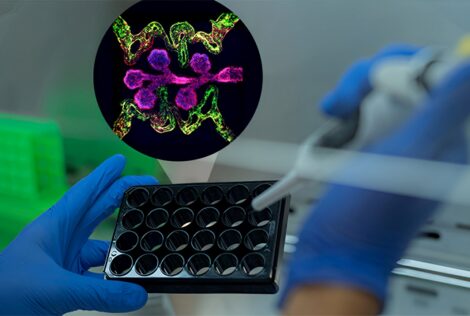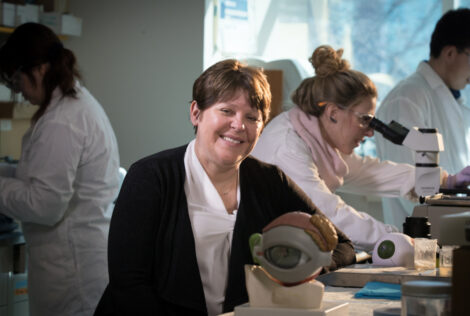

What if eye drops and injections used to treat eye diseases could be made to last longer in the eye, improving patient outcomes and reducing visits to the doctor? What if this drug delivery method could be applied to the lung, potentially improving outcomes for COVID-19 patients?
In Episode 8 of Big Ideas for a Changing World, hear how McMaster engineers at the Sheardown Lab are doing just that.
Heather Sheardown, a professor in Chemical Engineering and Tier 1 Canada Research Chair in Ophthalmic Biomaterials, has been working on improving drug delivery systems to the eye for more than 30 years.
Her team’s technologies increase the length of time eye drops and other medications last on – or inside – the eye. This improves the overall treatment experience and outcomes for people with diseases such as glaucoma and age-related macular degeneration, both of which affect millions of Canadians and may lead to vision loss.
Earlier this year, her team began applying their drug delivery systems to the lung after realizing the nasal passages and the lung have a similar mucin structure to the front of the eye.
“Our drug delivery system is based on adhesion to the mucous layer of the front of the eye, and we know that the adhesion lasts for at least four days,” says Sheardown. “So we thought, why not look at the potential of our mucoadhesive micelle system to deliver drugs to the nasal passageways and the lung – to either mitigate COVID-19 or treat it once it had gained traction?”
Working together with industrial partners, the team is nearing completion of the preclinical work associated with testing their system with several drugs used in the treatment of COVID-19.
“Because of the urgency of the situation, we’re looking at some accelerated timelines with industrial partners who have supported us through grants,” says Fran Lasowski, a recent PhD graduate in Chemical Engineering and the executive director for the C20/20 Innovation Hub, a research network stemming from the 20/20 NSERC Ophthalmic Materials Network.
“The mission behind the C20/20 Innovation Hub is to take these technologies, work with investors and clinical partners and drive them into patients’ hands to improve their lives,” adds Lasowski, a former Vanier Scholar.
The team has already licensed four drug delivery technologies for the eye since the C20/20 Innovation Hub’s inception, with one more pending by mid-2021.
Sheardown says the commercialization hub, funded by the Ontario Research Fund, is critical in moving new technologies forward while creating new jobs and wealth in Ontario.
One of the things I’ve learned is that engineers have so much to offer to the field of medicine. When physicians articulate a problem and say, ‘I wish I had something that could do this,’ we’re sort of like their magic wand that’s able to deliver a solution for their problem.
Read more about the C20/20 Innovation Hub and the Sheardown Lab.
Subscribe and listen to Big Ideas for a Changing World. Available on YouTube, Spotify, Apple Podcasts and Google Podcasts.


